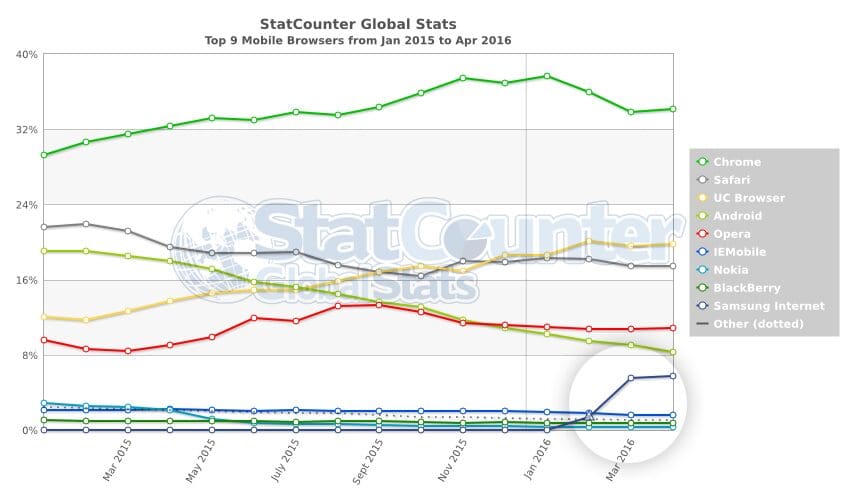If browser developers and online video providers have one thing in common, it’s that their future success will depend a lot on HTML5 browser support.
Online video is growing. Every year the statistics show more video being watched online. We see the percentage of time spent watching video surpassing any other activity, and we see the percentage of video watched online, as opposed to through traditional media sources, continually increasing.
As the trend towards online video and away from traditional TV continues, internet browsers will have a more and more prominent role in the lives of everyday people. How these browsers perform in relation to video playback is critical for both media content providers and to the success or failure of the browsers themselves.
Today’s Browser Landscape
Since the launch of Google Chrome in 2008, its rise to the top of the browser leaderboard has been relentless. In just a few years Chrome has stripped market share away from its two main competitors, overtaking Firefox in 2011, then Internet Explorer in 2012.
Most sources measure Chrome’s current market share at well over 50% and still growing, with Firefox a distant memory at around 15% and Internet Explorer even further below that and still on a very steep downward trend.

There is, however, a lot more to the story. As you delve deeper into the statistics, pockets of resistance can be seen. Safari, supported by the unshakable loyalty of the Mac community has held its ground, and if Firefox and IE continue to slide, Safari may well find itself in second position.
Looking a little deeper, other browsers can be seen gaining market share in particular areas, such as UC Browser which, despite falling behind Chrome in China, is still holding a very strong position in India. And that is no small thing. According to InternetLiveStats.com, in the last two years India has doubled the number of internet users to almost half a billion, pushing it past the USA into second place after China for the total number of internet users.
Samsung Internet V4 is another browser to watch. The latest version of this browser has just this year sprung from nowhere up to 5% market share on mobile platforms, according to statcounter.com. It’s success seems to be based on the quality of the browser which has improved security and privacy functionality, is ready for VR, and most importantly, scores very highly on HTML5 compatibility tests.

The Key to Success is HTML5 Browser Support
HTML5 is the language of the internet, and browsers that are better at displaying HTML5 obviously have a clear advantage. They are faster, they are more secure and they make websites easier to use. Internet Explorer’s historical reluctance to adopt HTML standards has made it very hard to work with. This is the main source of its unpopularity within the web development community and has led to more and more websites choosing not to support older versions of IE, which in turn has driven users to try other browsers. This is very likely to be a major contributing factor in IE’s dramatic slide from the 90+% market share it held in the early 2000s.
Chrome on the other hand gets top scores across mobile, desktop and tablet devices for HTML5 compliance. In addition to the fact that Chrome is simply better at displaying websites, Google has also created a lot of integration options for Chrome, in particular with the other Google products, further enhancing the user experience and generally making everyone’s life easier.
It’s very clear that the overwhelming trend is towards HTML5 compliance, both in terms of consumer demand, and industry direction.

The graph above shows the improvement in HTML5 compliance for the major browsers. The graph and data was taken from HTML5test.com. It’s very clear that the overwhelming trend is towards HTML5 compliance, both in terms of consumer demand, and industry direction.
How Does all This Relate to Video?
In the last couple of years video has overtaken social media as the main activity on the internet. In the same way that Chrome devoured IE and Firefox, online video is eating away at traditional TV. People are now spending more time watching video than any other online activity.
Furthermore, the sharpest growth in video consumption is not on desktop but rather on tablets, mobile and smart TV. To add fuel to the fire, the next generation of online video looks to be predominantly driven by VR and 360° which will further increase the percentage of users viewing online content on internet devices rather than traditional devices.
The range of devices and browsers that your video needs to play on is expanding, but how do you ensure your video will play on the new platforms?
The upshot of this for content providers is that the range of devices and browsers that each video needs to play on is expanding. Samsung Internet is a great example of a new browser appearing out of the blue and taking 5% of the market.
The big challenge for video content providers is to future proof your platforms to ensure that it will be compatible with new browsers as they enter the market. The best way to do that is to move in the same direction as the successful browsers, and that means HTML5 compliance.
How Reliable is HTML5 Video Browser Support?
As we have seen, Google Chrome is dominating with well over 50% market share and Chrome’s HTML5 compliance is outstanding, scoring 521 out of 555 on the HTML5test.com website, the highest result out of all the browsers, but the other browsers are working hard to catch up. Every major browser supports the HTML5 Video element and since early 2016 they also all support Media Source extensions, with one exception. iOS on Mac does not support MSE, but adaptive streaming video can be played through HTML5 by using Apple HTTP Live Streaming (HLS). The Bitmovin player supports MPEG-DASH and HLS in HTML5 on all major browsers as shown in our browser compatiblity matrix.
The Safest Bet on the Internet
So far HTML5 has proven itself capable of handling everything that the video industry could throw at it, through the use of Media Source Extensions (MSE).
The improvement of video quality to match standard HDTV and even higher resolutions, was one of the first challenges to overcome. MPEG-DASH via HTML5 meets this challenge by allowing the video stream to adapt dynamically, switching between video quality levels as bandwidth allows.
Digital Rights Management (DRM) is a hurdle that video providers must overcome before they offer premium content, and is another good example of a problem solved by HTML5 via its Encrypted Media Extensions.
Virtual reality, 360°, adserver technology, analytics, etc. all of these challenges have been met and can be delivered to an HTML5 compliant browser through an HTML5 adaptive streaming player.
The landscape will continue to change, but one thing that is becoming more and more predictable is HTML5 and the way that browsers interpret it. In fact the trend towards browser compliance and consistent representation of HTML5 is probably the safest bet on the internet right now.
See an HTML5 Adaptive Player in Action
This is the Bitmovin Adaptive Streaming Player in action. It plays with fast startup, no buffering and can be installed and used for free, with paid accounts available for high volume websites.
[bitmovin_player id=’8435’/]
To find out more about video playback through HTML5 have a look at our HTML5 Player




